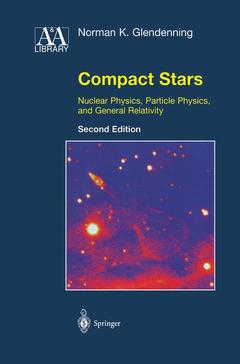Description
Compact Stars (2nd Ed., 2nd ed. 2000)
Nuclear Physics, Particle Physics, and General Relativity
Astronomy and Astrophysics Library Series
Author: Glendenning Norman K.
Language: English
Subject for Compact Stars:
Compact Stars (2nd Ed.)
Publication date: 09-2012
468 p. · 15.5x23.5 cm · Paperback
Publication date: 09-2012
468 p. · 15.5x23.5 cm · Paperback
Compact stars: nuclear physics, particlephysics & general relativity 2nd ed 2000
Publication date: 06-2000
468 p. · 15.5x23.5 cm
Publication date: 06-2000
468 p. · 15.5x23.5 cm
Description
/li>Contents
/li>
White dwarfs, neutron stars, and (solar mass) black holes are the collapsed cores of stars which, near the ends of their luminous lives, have shed most of their mass in supernova explosions or other, less spectacular, instabilities. Here gravity crushes matter to realms that lie far beyond present empirical knowledge. This book explores the diverse forms that such compact stars can possibly take, as constrained by the laws of nature: the general principles of relativity and quantum mechanics, the properties of nuclear matter deduced from nuclei, and the asymptotic freedom of quarks at high density. The book is self contained. It reviews general relativity, essential aspects of nuclear and particle physics, and general features of white dwarfs, neutron stars and black holes; it includes background on such matters as stellar formation and evolution, the discovery of pulsars and associated phenomena, and the strange-matter hypothesis. The book develops a theory for the constitution of neutron stars and the more exotic Hyperon Stars, Hybrid Stars (containing a quark matter core surrounded by an intricate lattice of quark and hadronic matter) and Strange Stars and Dwarfs (composed of the three light quark flavors sheathed in a solid skin of heavy ions). This second edition has been revised throughout to clarify discussions and bring data up to date; it includes new figures, several new sections, and new chapters on Bose condensates in neutron stars and on phase transitions.
1 Introduction.- 1.1 Compact Stars.- 1.2 Compact Stars and Relativistic Physics.- 1.3 Compact Stars and Dense-Matter Physics.- 2 General Relativity.- 2.1 Relativity.- 2.2 Lorentz Invariance.- 2.3 Scalars, Vectors, and Tensors in Curvilinear Coordinates.- 2.4 Principle of Equivalence of Inertia and Gravitation.- 2.5 Gravity.- 2.6 Covariance.- 2.7 Riemann Curvature Tensor.- 2.8 Einstein’ Field Equations.- 2.9 Relativistic Stars.- 2.10 Action Principle in Gravity.- 2.11 Problems for Chapter 2.- 3 Compact Stars: From Dwarfs to Black Holes.- 3.1 Birth and Death of Stars.- 3.2 Objective.- 3.3 Gravitational Units and Neutron Star Size.- 3.4 Partial Decoupling of Matter from Gravity.- 3.5 Equations of Relativistic Stellar Structure.- 3.6 Electrical Neutrality of Stars.- 3.7 “Constancy” of the Chemical Potential.- 3.8 Gravitational Redshift.- 3.9 White Dwarfs and Neutron Stars.- 3.10 Improvements in White Dwarf Models.- 3.11 Temperature and Neutron Star Surface.- 3.12 Stellar Sequences from White Dwarfs to Neutron Stars.- 3.13 Baryon Number of a Star.- 3.14 Binding Energy of a Neutron Star.- 3.15 Star of Uniform Density.- 3.16 Scaling Solution of the OV Equations.- 3.17 Bound on Maximum Mass of Neutron Stars.- 3.18 Stability.- 3.19 Beyond the Maximum-Mass Neutron Star.- 3.20 Black Holes.- 3.21 Problems for Chapter 3.- 4 Relativistic Nuclear Field Theory.- 4.1 Motivation.- 4.2 Lagrange Formalism.- 4.3 Symmetries and Conservation Laws.- 4.4 Boson and Fermion Fields.- 4.5 Properties of Nuclear Matter.- 4.6 The ? — ? Model.- 4.7 Stationarity of Energy Density.- 4.8 Model with Scalar Self-Interactions.- 4.9 Introduction of Isospin Force.- 4.10 Inclusion of the Octet of Baryons.- 4.11 High-Density Limit.- 4.12 Effective Versus Renormalized Theory.- 4.13 Bound Versus UnboundNeutron Matter.- 4.14 Note on Dimensions.- 4.15 Summary.- 4.16 Problems for Chapter 4.- 5 Neutron Stars.- 5.1 Discovery.- 5.2 Pulsars: The Observational Basis of Neutron Stars.- 5.3 Theory of Neutron Stars.- 5.4 Constitution of Neutron Stars.- 5.5 Tables of Equations of State.- 5.6 Problems for Chapter 5.- 6 Rotating Neutron Stars.- 6.1 Motivation.- 6.2 Dragging of Local Inertial Frames.- 6.3 Interior Solution for the Dragging Frequency.- 6.4 Moment of Inertia of a Rotating Relativistic Star.- 6.5 Kepler Angular Velocity in General Relativity.- 6.6 Effect of Frame Dragging on Kepler Frequency.- 6.7 Approximation to the Kepler Frequency.- 6.8 Hartle—Thorne Perturbative Solution.- 6.9 Imprint of Angular Momentum.- 6.10 Rotating Stars with Realistic Equations of State.- 6.11 Effect of Rotation on Stellar Structure.- 6.12 Gravitational-Wave Instabilities.- 6.13 Problems for Chapter 6.- 7 Limiting Rotational Period and Radius of Neutron Stars.- 7.1 Motivation.- 7.2 The Minimal Constraints.- 7.3 Variational Ansatz.- 7.4 Limiting Value of Rotational Period as a Function of Mass.- 7.5 Test of Sensitivity of Results.- 7.6 General Relativistic Limit on Rotation.- 7.7 Lower Limit on Neutron Star Radius.- 7.8 Discussion and Alternatives.- 7.9 Self-Bound Stars.- 7.10 Summary.- 8 Quark Stars.- 8.1 Introduction.- 8.2 Model of Quark Confinement.- 8.3 Quark Matter Equation of State.- 8.4 Quark Star Matter.- 8.5 Strange and Charm Stars.- 8.6 Problems for Chapter 8.- 9 Hybrid Stars.- 9.1 Introduction.- 9.2 Constant-Pressure Phase Transition.- 9.3 The Confined—Deconfined Phase Transition in Neutron Stars.- 9.4 Large-Scale Structure of a Hybrid Star.- 9.5 Crystalline Structure of the Mixed Phase.- 9.6 Tables of Equation of State for Hybrid Stars.- 9.7 Problems for Chapter 9.- 10 BoseCondensates in Neutron Stars.- 10.1 Relativistic Mean—Field Model with Kaons.- 10.2 Equation of State with a Kaon Condensate.- 10.3 Stellar Properties.- 10.4 Summary.- 10.5 Problems for Chapter 10.- 11 Consequences and Signals of Phase Transitions.- 11.1 Introduction.- 11.2 Mechanism for Formation of Low-Mass Black Holes.- 11.3 A Third Class of Stable Compact Stars.- 11.4 Phase Transition Signal in Pulsar Timing.- 11.5 Caveats.- 12 Strange Stars.- 12.1 The Strange Matter Hypothesis.- 12.2 Compatibility of the Hypothesis with Present Knowledge.- 12.3 Submillisecond Pulsars.- 12.4 Structure of Strange Stars.- 12.5 Simultaneous Existence of Strange and Neutron Stars.- 12.6 Strange Stars to Strange Dwarfs.- 12.7 Conclusion.- Useful Astronomical Data.- Books for Further Study.- References.
© 2024 LAVOISIER S.A.S.




